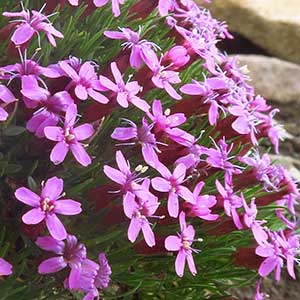Silene acaulis
Silene hitchguirei
moss campion, silène acaule
mountain campion
erect, leafy proximally, 3–6(–15) cm, old leaves persistent at base.
several, stiffly erect, 2–10(–12) cm, densely pubescent distally, hairs multicellular, with glandular tip;
stem leaves in 1 or 2 pairs.
mostly basal, densely crowded and imbricate, sessile;
blade 1(–3)-veined, linear-subulate to lanceolate, 0.4–1(–1.5) cm × 0.8–1.5(–2) mm, margins cartilaginous, often ciliolate especially proximally, apex acute, glabrous to scabrous.
blade narrowly oblanceolate and long-spatulate, to 2.5 cm × 4 mm, somewhat fleshy, apex acute, ± glabrous except for ciliate margins.
solitary flowers.
1(–3) per flowering stem.
2–40 mm.
bisexual or unisexual, all plants having both staminate and pistillate flowers, others having only pistillate flowers, subsessile or borne singly on peduncle;
calyx 10-veined, lateral veins absent, tubular to campanulate, (5–)7–10 mm, herbaceous, margins often purple tinged, dentate, sometimes ciliate, ± scarious, glabrous, lobes lanceolate to ovate, 1–2 mm;
petals bright pink, rarely white, limb unlobed to shallowly 2-fid, 2.5–3.5 mm, base tapered into claw, auricles and appendages poorly developed;
stamens exserted in staminate flowers, not so or aborted in pistillate flowers;
styles 3.
erect;
mature calyx veined, elliptic, not inflated or thin, 7–10(–12) mm, densely pubescent with purple-septate hairs, margins dentate with 1–1.5 mm lobes, apex acute, outwardly curved, veins not much- broadened distally, intermediate ones shorter than calyx, veins and calyx lobes dark purple;
petals white or pink, to 11/4 times calyx, claw narrow, 10–12 mm, limb not differentiated from claw, obovate, emarginate, ca. 3 mm;
stamens equaling calyx;
styles 5, equaling calyx.
3-locular, cylindric, equaling or to 2 times calyx, opening by 6 recurved teeth;
carpophore ca. 1 mm.
equaling calyx, opening by 5 teeth, tardily splitting into 10, triangular, outwardly curved.
light brown, reniform, 0.8–1(–1.2) mm broad, dull, shallowly rugose.
brown, reniform to angular, (0.5–)0.7–1(–1.3) mm diam., wrinkled, wing narrow, less than 1/4 diam. of seed.
= 24.
= 24.
Silene acaulis
Silene hitchguirei
Silene acaulis is a variable species, and most workers have recognized infraspecific taxa in North America: subsp. acaulis (subsp. exscapa and subsp. arctica), which is predominantly arctic; and subsp. subacaulescens, which extends down the Rocky Mountains from Alaska to Arizona and New Mexico. In subsp. acaulis, the leaves are flat and short and the flowers are subsessile and smaller in size. Subspecies subacaulescens is typically a larger, less-compact plant with longer, narrower leaves and larger, pedunculate flowers. However, in many populations, these two variants are poorly differentiated, and in others both occur together, connected by intermediates.
Silene acaulis is widely distributed in arctic and alpine Europe.
(Discussion copyrighted by Flora of North America; reprinted with permission.)
Silene hitchguirei is similar to S. suksdorfii, except that the latter species has larger seeds, an urceolate fruiting calyx with a contracted base, an inflorescence that is sometimes branched with up to three flowers, and short, erect stems that have three or four pairs of leaves. It is probably closely related to S. involucrata subsp. tenella and S. ostenfeldii but differs in its small size, its usually solitary flowers, and short petals. The wing on its small seeds is narrower than that of S. involucrata subsp. tenella, whereas in S. ostenfeldii the wing is completely absent.
(Discussion copyrighted by Flora of North America; reprinted with permission.)


